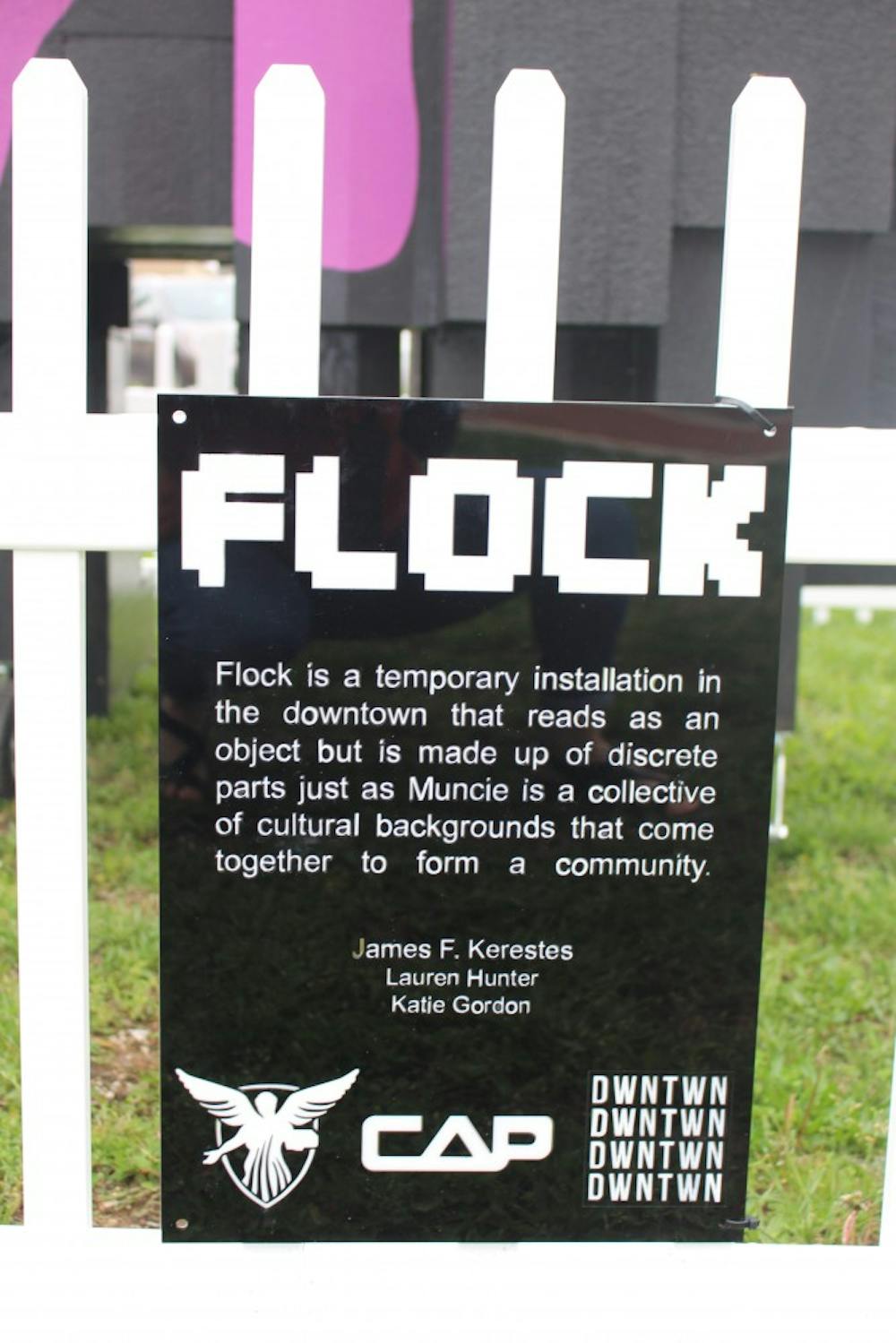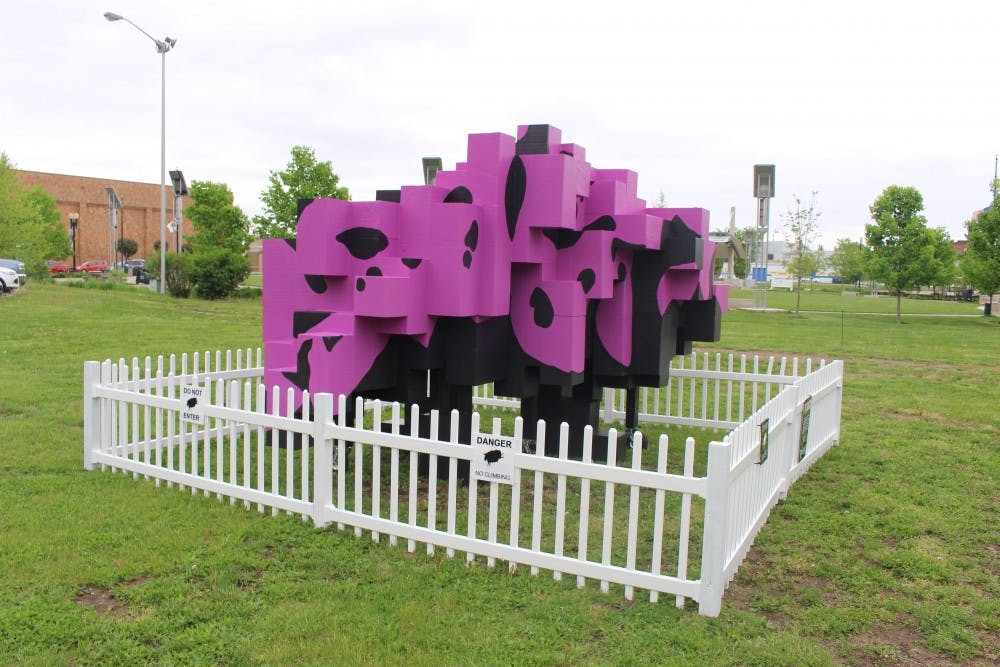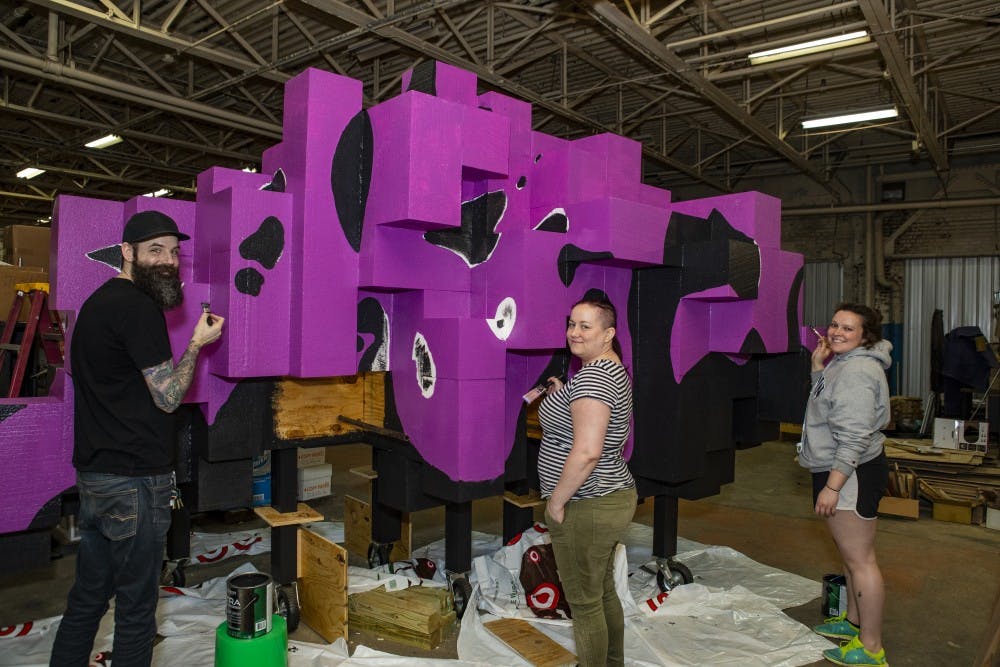Is it a cube? Is it a sheep? Does it appear different depending on how one looks at it? Is it a “cubist version of Dino from ‘The Flintstones’?”
According to James Kerestes, assistant professor of architecture, Muncie’s newest art installation “Flock” represents Muncie as a community – diverse and more than just the whole.
“It’s to recognize the fact that Muncie is not just Ball State,” Kerestes said. “It’s to recognize that there are a lot of neighborhoods and a lot of people in Muncie, and I think it’s important that it’s inclusive.”
Made up of 238 individual styrofoam cubes painted purple with black spots, “Flock” is an art installment put together by Ball State’s College of Architecture and Planning in partnership with Muncie Downtown Development. It was made to lightly resemble a sheep, and at its widest, it’s anywhere from 8-13 feet long and just over 9 feet tall.
“Flock” was originally supposed to be displayed at First Thursday May 2 in downtown Muncie as part of the Artswalk. However, due to weather, the installation was moved into Madjax, where YART, a yard sale for art, was held at the same time.
This helped the installation get exposure in the local community, Kerestes said.

A description of the art installation is displayed on the fence protecting the "Flock" art installation in Canan Commons. James Kerestes, assistant professor of architecture who worked on the installation, said the main goal of “Flock” was to find ways to tie the College of Architecture and Planning to the Muncie community. Demi Lawrence, DN
Kerestes worked on “Flock” with two Ball State students. Lauren Hunter worked on the installation for the fall and spring semesters while Katie Gordon worked on it only for the spring semester. Hunter said “Flock” pushed her as a student, and means a lot to her because of the time and effort she was able to give it.
“I had never been involved with a design-build before working on this project,” Hunter said. “The team that worked on FLOCK [sic] was also rather small so everyone that worked on the project became close. It was an amazing opportunity to work on this project and to collaborate with so many new people.”
Kerestes said The main goal of “Flock” was to find ways to tie CAP to the Muncie community.
“It’s a little bit cheesy but the idea was is that when someone in the community asks me what it is, I basically just say it's somewhat like Muncie,” he said. “It reads as a whole, but it’s made up of all these individual parts. It’s all different cultures, communities, organizations, and so the whole is only as strong as the individual part.”
The idea to make the art installation resemble a sheep came from Kerestes’ work early in the fall with the Chicago Stockyards. Kerestes saw many qualities of Muncie and other industrial towns in this district of Chicago, and had an emotional connection with the animals involved with it. With that fresh in his mind, he and his team looked to find animals that travelled in groups, but did not have a dominant or elite member of that group. Thus, they found the sheep.
“Muncie is all variations of the same people, and it's not just this person or community or group,” Kerestes said.

The finished art installation called "Flock" sits at the Canan Commons in downtown Muncie. James Kerestes, assistant professor of architecture who worked on the installation, said the installations might reside in Muncie Makers Lab indefinitely. Demi Lawrence, DN
From every different angle, the installation can appear to look or lay differently. This was deliberate, according to Kerestes, and something he is interested in personally.
“When you look at this thing, it doesn’t have a top or a back or a front, we could have flipped it around in so many different ways, and to me it was important to think about Muncie in that way, too,” Kerestes said. “It’s not just a hierarchy that maybe people are familiar with. It really can be more spread out and thought of as a non-hierarchical field of things that without them collectively, you don’t get the character and the language of Muncie.”
“Flock” will reside in either Canan Commons or Muncie Makers Lab until further notice. Kerestes plans to disassemble the installation and recycle the styrofoam at some point. But for now, “Dino” as he, Hunter and Gordon liked to call it, will serve as a symbol for Muncie itself.
Contact Demi Lawrence with any comments at dnlawrence@bsu.edu or on Twitter @demiilawrencee.




